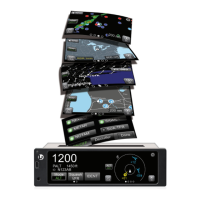Lynx
®
NGT-9000
Pilot’s Guide1-12
Description
Product deScriPtion
AIRMET Airmen’s Meteorological Information is a weather ad-
visory issued by a meteorological watch office a po-
tentially hazardous condition exists for low-level air-
craft and/or aircraft with limited capability. Compared
to SIGMETs, AIRMETs cover less severe weather:
moderate turbulence and icing, surface winds of 30
knots, or widespread restricted visibility.
METAR Aviation routine weather report is a format for report-
ing weather information. METARs are predominantly
used by pilots in fulfillment of a pre-flight weather
briefing. METARs typically come from airports or per-
manent weather observation stations.
NEXRAD,
Regional
Next-Generation Radar is a nationwide network of
high resolution Doppler weather radars, which detect
precipitation and atmospheric movement or wind. It
returns data which when processed can be displayed
in a mosaic map which shows patterns of precipita-
tion and its movement. The “Regional NEXRAD” FIS-
B product is a composite of available NEXRAD radar
imagery in a local area, showing a more detailed im-
age than the “CONUS NEXRAD” product.
NEXRAD,
CONUS
The “CONUS NEXRAD” FIS-B product is a sum-
mary composite of available NEXRAD radar imagery
across the 48 states.
NOTAM Notice To Airmen is created and transmitted by gov-
ernment agencies under guidelines specified by
Annex 15: Aeronautical Information Services of the
Convention on International Civil Aviation. A NOTAM
is filed with an aviation authority to alert aircraft pilots
of any hazards En Route or at a specific location.
The FIS-B NOTAM product consists of NOTAM-Ds
and NOTAM-FDCs (including TFRs).
SIGMET Significant Meteorological Information is a concise
description of the occurrence or expected occurrence
of specified En Route weather phenomena which
may affect the safety of aircraft operations. SIGMETs
are intended for dissemination to all pilots in flight to
enhance safety.
Table 1-2: Description of FIS-B Available Information

